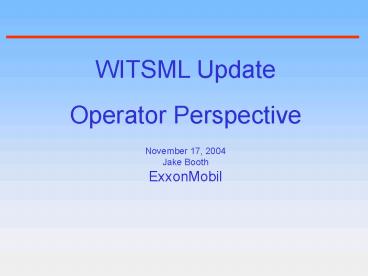WITSML Update - PowerPoint PPT Presentation
1 / 11
Title: WITSML Update
1
WITSML Update Operator Perspective November 17,
2004 Jake Booth ExxonMobil
2
Agenda
- Background - Post Merger (1999)
- Process-based, Phased Approach to Integration
- Need For Internal Standards
- Fluid Property Data
- Mud Log Data
- WITSML Participation - Industry Standards
2
3
Post-Merger History
Phases of evolution of Technical Computing
Environment
Move
Move
Stabilize
Stabilize
Standardize Round 2 XME
Standardize
Rationalization of Engineering Applications
Standardize
Optimize
Optimize
2000
2002
2003
2004
- Driven by the need to integrate
- Experience
- Get Common Before We Get Best
- time and cost constraints
- Standardization does generate value
- reduced expense despite business growth
- and creates opportunity
- consistency is the fulcrum of improvement
- Current Effort
- Optimization is actively being driven by
ExxonMobils view of what we want our technical
computing system to become (and evolving IT
technologies)
4
Integration Value Hierarchy
Higher
Integration Automation
Work Practices
Data Practices
Data Practices
Business Engagement
Value
Data Entry, Q.C., Retrieval Tools
Data Model
Applications
Hardware
Higher
Low
Higher
Low
Higher
4
Complexity
Complexity
5
Workflow Driven Optimization
6
Approach to Data Standards
- Workflow-based approach to integration
- Recognized need for internal data standards
- Recognized evolution of integration from tight
(e.g. Shared Earth Model) to loose (e.g.
Digital Oil Field). - Identified opportunities
- PVT Data
- Mud Log Data
- Implemented Internal PVT Standards
- design and implement an XML-based system
- exchange and communicate fluid property data
- improve internal and external work processes
- Improve efficiency and accuracy in capture and
use of fluid property data - Improve management of these data
7
PVT Workflow - Implementation
8
WITSML more than just Rig Site data
- Addresses basic issues like . . .
- What does this data mean? ? Gives common
definitions - How is this data identified? ? Creates common
context - How do I read/write the data? ? Provides common
format, structure and rules - Where do I put the data? Where can I get the
data? ? Provides common services - How do I change or extend the standard? ?
Provides community for change - Where do I start? Who can I work with? ?
Provides community of experience
9
Mud Log Standard - Status
- Mudlog Data Content
- Objective Extend the WITSML objects to contain
additional mudlog elements - Use Case Team Small focus group consisted of
representatives from WITSML participating
companies starting from ExxonMobil submissions - WITSML Extensions Recommendations for WITSML
extensions to Version 1.2 have been submitted to
the Technical Committee for review - Additional WITSML Involvement
- Invitation information has been sent to other
companies that expressed an interest in possible
pilot work - Presently engaging mudlogging companies, software
development and other operating companies - Mudlog Process Pilot
- Objective To support/improve/simplify the work
practices of Operations Geology in generating,
distributing and receiving Mudlog data - First Candidate an ExxonMobil operating unit has
agreed to use this WITSML extension on a well
soon to be drilled
10
Opportunities to improve in WITSML
- Multiple implementations of well deviation data
have been created including WITSML, UKOOA, POSC,
PPDM, US MMS, various operators and many vendors - Different phases of data life cycle supported
- planned data
- acquisition data
- processed (actual) data
- archived data
- Create more consistent and correct geospatial
well locations and wellbore paths, including
transformations and processing requirements - depth and azimuth references
- geodetic co-ordinate reference systems (EPSG)
- surface locations
- well path (trajectory) data
11
Constraints
- Any solution must work within ExxonMobils
existing technical computing environment - globally implemented system (hardware, network
ids, applications, databases, etc.) is a
consistent mix of commercial and proprietary
products - fluid characterization application and fluid
property database are proprietary components - Workable with external work processes
- as close to seamless as possible
- product independent technology
- Retain value of existing data and work processes
- Move towards industry standardization































